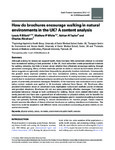How do brochures encourage walking in natural environments in the UK? A content analysis
| dc.contributor.author | Elliott, LR | |
| dc.contributor.author | White, MP | |
| dc.contributor.author | Taylor, Adrian | |
| dc.contributor.author | Abraham, C | |
| dc.date.accessioned | 2017-08-10T11:00:08Z | |
| dc.date.available | 2017-08-10T11:00:08Z | |
| dc.date.issued | 2018-04 | |
| dc.identifier.issn | 0957-4824 | |
| dc.identifier.issn | 1460-2245 | |
| dc.identifier.uri | http://hdl.handle.net/10026.1/9718 | |
| dc.description.abstract |
Although walking for leisure can support health, there has been little systematic attempt to consider how recreational walking is best promoted. In the UK, local authorities create promotional materials for walking networks, but little is known about whether they effectively encourage walking through persuasive messaging. Many of these materials pertain to walks in natural environments which evidence suggests are generally visited less frequently by physically inactive individuals. Consequently the present study explores whether and how recreational walking brochures use persuasive messages in their promotion of walks in natural environments. A coding taxonomy was developed to classify text in recreational walking brochures according to five behavioural content areas and 87 categories of potentially persuasive messages. Reliability of the taxonomy was ascertained and a quantitative content analysis was applied to 26 brochures collected from Devon, UK. Brochures often provided information about an advertised route, highlighted cultural and aesthetic points of interest, and provided directions. Brochures did not use many potentially effective messages. Text seldom prompted behaviour change or built confidence for walking. Social norm related information was rarely provided and there was a general lack of information on physical activity and its benefits for health and well-being. The limited range of message strategies used in recreational walking brochures may not optimally facilitate walking in natural environments for inactive people. Future research should examine the effects of theory-informed brochures on walking intentions and behaviour. The taxonomy could be adapted to suit different media and practices surrounding physical activity in natural environments. | |
| dc.format.extent | daw083-daw083 | |
| dc.format.medium | ||
| dc.language | en | |
| dc.language.iso | eng | |
| dc.publisher | Oxford University Press (OUP) | |
| dc.subject | physical activity | |
| dc.subject | nature | |
| dc.subject | recreation | |
| dc.subject | environment and public health | |
| dc.subject | exercise | |
| dc.title | How do brochures encourage walking in natural environments in the UK? A content analysis | |
| dc.type | journal-article | |
| dc.type | Journal Article | |
| plymouth.author-url | https://www.webofscience.com/api/gateway?GWVersion=2&SrcApp=PARTNER_APP&SrcAuth=LinksAMR&KeyUT=WOS:000429490000012&DestLinkType=FullRecord&DestApp=ALL_WOS&UsrCustomerID=11bb513d99f797142bcfeffcc58ea008 | |
| plymouth.issue | 2 | |
| plymouth.volume | 33 | |
| plymouth.publication-status | Published online | |
| plymouth.journal | Health Promotion International | |
| dc.identifier.doi | 10.1093/heapro/daw083 | |
| plymouth.organisational-group | /Plymouth | |
| plymouth.organisational-group | /Plymouth/Faculty of Health | |
| plymouth.organisational-group | /Plymouth/Faculty of Health/Peninsula Medical School | |
| plymouth.organisational-group | /Plymouth/REF 2021 Researchers by UoA | |
| plymouth.organisational-group | /Plymouth/REF 2021 Researchers by UoA/UoA03 Allied Health Professions, Dentistry, Nursing and Pharmacy | |
| plymouth.organisational-group | /Plymouth/Research Groups | |
| plymouth.organisational-group | /Plymouth/Research Groups/FoH - Community and Primary Care | |
| plymouth.organisational-group | /Plymouth/Research Groups/Institute of Health and Community | |
| plymouth.organisational-group | /Plymouth/Research Groups/Institute of Translational and Stratified Medicine (ITSMED) | |
| plymouth.organisational-group | /Plymouth/Research Groups/Institute of Translational and Stratified Medicine (ITSMED)/CCT&PS | |
| plymouth.organisational-group | /Plymouth/Research Groups/Plymouth Institute of Health and Care Research (PIHR) | |
| plymouth.organisational-group | /Plymouth/Users by role | |
| plymouth.organisational-group | /Plymouth/Users by role/Academics | |
| plymouth.organisational-group | /Plymouth/Users by role/Researchers in ResearchFish submission | |
| dc.publisher.place | England | |
| dc.identifier.eissn | 1460-2245 | |
| dc.rights.embargoperiod | No embargo | |
| rioxxterms.versionofrecord | 10.1093/heapro/daw083 | |
| rioxxterms.licenseref.uri | http://www.rioxx.net/licenses/all-rights-reserved | |
| rioxxterms.type | Journal Article/Review | |
| plymouth.oa-location | https://academic.oup.com/heapro/article-lookup/doi/10.1093/heapro/daw083 |


